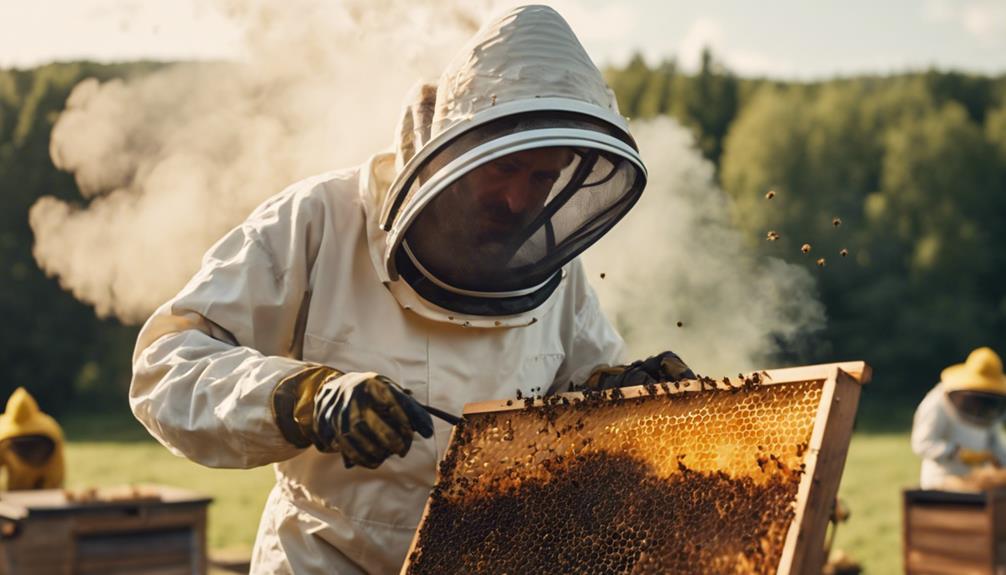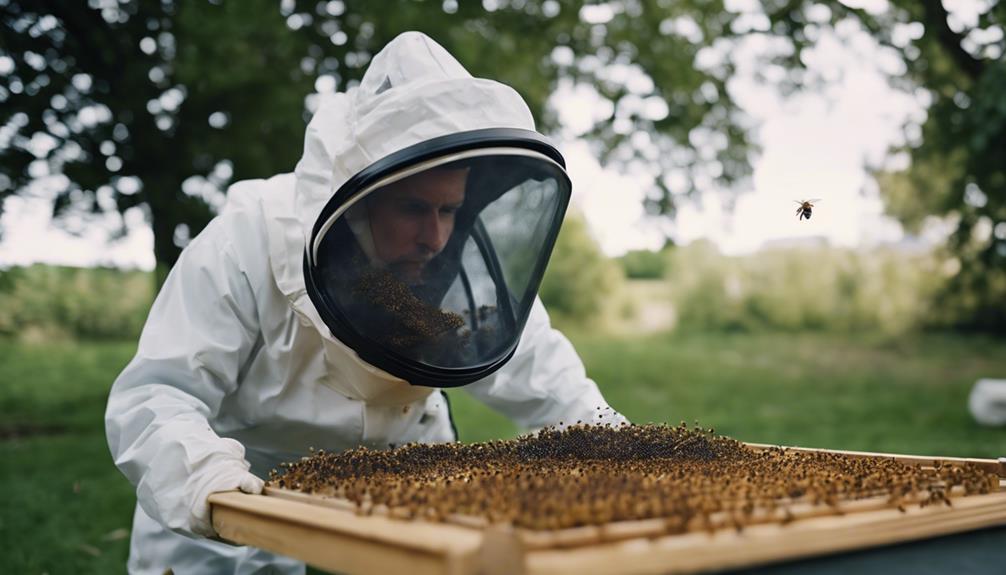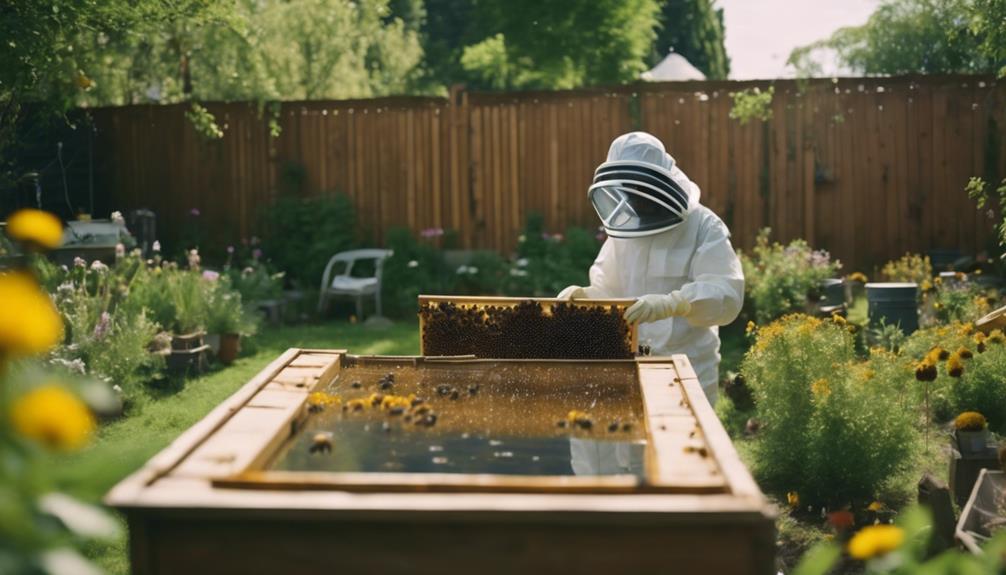Beekeepers use smokers to keep bees calm, minimize stings, and foster a positive relationship with their hives. The smoke helps in calming bees by disrupting their pheromone sensitivity and signaling them to focus on consuming honey rather than defensive behaviors. It’s like a gentle nudge for the bees to stay cool and content while we check on them. The last thing you want is an angry swarm buzzing around, right? If you’re curious about how exactly smoke achieves these effects, there’s a fascinating harmony between nature’s cues and bees’ instincts that you’ll discover.
Main Points
- Calms bees during hive inspections
- Masks alarm pheromones for safety
- Promotes feeding behavior for distraction
- Disrupts defensive responses effectively
- Ensures a harmonious hive environment
Importance of Bee Smokers
Beekeepers rely on smokers as essential tools for maintaining hive safety and efficiency during inspections. The smoke from these devices plays a vital role in keeping the bees calm and reducing the risk of stings. By interfering with the bees’ pheromone sensitivity, smoke helps prevent aggressive behavior, creating a safer environment for both the bees and the beekeepers.
When smoke is applied correctly, it triggers the bees’ instinctual response to wildfires, distracting them from feeling threatened and allowing beekeepers to work without causing harm. This method not only guarantees the safety of the beekeepers but also helps in managing the hive effectively. The use of smokers is a fundamental aspect of beekeeping that promotes a harmonious relationship between humans and bees.
How Smoke Affects Bees
When we introduce smoke into a hive, it works wonders on the bees. The smoke not only calms them but also masks their alarm pheromones, keeping the hive peaceful and reducing the likelihood of stings.
Additionally, the bees interpret the smoke as a signal to focus on consuming honey, making hive inspections smoother and safer for beekeepers.
Bee Calming Effect
Inducing a calming effect on bees, smoke disrupts their pheromone sensitivity, reducing their responsiveness to alarm signals. When smoke wafts through the hive, bees interpret it as a wildfire approaching, triggering a natural response to protect their honey stash.
Here’s how the Bee Calming Effect works:
- Bees interpret smoke as a sign of danger, prompting them to gorge on honey and relax.
- The use of smoke is a gentle way to manage bees without causing harm.
- Smoke disrupts bees’ communication and coordination, making them less likely to mount a defensive response.
- Bees return to normal after the smoke dissipates, resuming their pheromone sensitivity.
- The Bee Calming Effect showcases nature’s intricate balance, highlighting the unique ways in which bees adapt to their environment.
Mask Alarm Pheromones
Masking alarm pheromones, smoke plays an important role in calming bees during hive inspections. When we use smoke, it interferes with the bees’ ability to send out alarm signals, disrupting their communication and preventing the spread of panic. This function of the smoker is essential for beekeeping safety, as it helps maintain a sense of calm within the hive.
By blocking these alarm pheromones, we reduce the chances of provoking defensive behavior in the bees, ultimately preventing unnecessary stinging incidents. The calming effect of smoke during hive inspections is a valuable tool for beekeepers, ensuring a smoother and safer experience for both the bees and us.
This simple yet effective method of alarm pheromone interference promotes a sense of tranquility and order, making hive inspections more manageable.
Promote Feeding Behavior
Smoke triggers bees to gorge on honey in preparation for leaving the hive, promoting feeding behavior and reducing defensive responses. When smoke wafts through the hive, it’s like a signal for the bees to stock up on honey, creating a calming effect that keeps everyone focused on filling their bellies rather than gearing up for battle.
This clever diversion not only helps beekeepers manage hives more effectively but also ensures that the bees are too busy indulging to bother with stinging intruders. So, next time you see a beekeeper puffing some smoke into a hive, remember it’s not just for show; it’s a strategic move to keep the peace and ensure everyone stays well-fed and content.
- Beekeepers strategically use smoke to keep bees focused on honey, not hostility.
- Smoke acts as a gentle reminder for bees to prioritize food, not fights.
- By promoting feeding behavior, smoke helps maintain a harmonious hive atmosphere.
- Gorging on honey under the influence of smoke helps bees stay calm and collected.
- Attention diversion through smoke ensures that bees remain occupied and content.
Beekeeper Safety and Smoke
When we approach beehives, safety is paramount. Using smokers is key to keeping us protected from bee stings.
The smoke helps calm the bees, making our work more manageable and ensuring a smoother hive inspection process.
Smoke Calms Bees
Using smoke in beekeeping operations has long been recognized as an essential tool for ensuring the safety of beekeepers and minimizing the risk of stings during hive inspections. When smoke calms bees by masking alarm pheromones, it helps reduce their defensive responses, making hive maintenance safer and easier. This traditional method, practiced for centuries, triggers bees’ instinctual response to wildfires, keeping them distracted and less likely to sting. Proper smoke use is pivotal for beekeeper safety during hive manipulations, ensuring a harmonious interaction with these buzzing creatures.
Embracing the art of beekeeping involves understanding the significance of smoke in fostering a peaceful coexistence between humans and bees, allowing for a symbiotic relationship rooted in mutual respect and freedom.
- Breathe in the sweet scent of smoke, calming both bees and beekeepers.
- Feel the ancient connection between humans and bees through this traditional practice.
- Witness the dance of bees, their instinctual response to smoke guiding hive interactions.
- Embrace the harmony of beekeeping, where safety and respect intertwine with the natural world.
- Experience the freedom of working alongside bees, united by the gentle power of smoke.
Enhances Beekeeper Protection
Beekeepers depend on smokers to ensure their safety from bee stings by soothing the bees in the hive. When we’re gearing up for hive inspections, smokers play an essential role in enhancing our protection.
By releasing smoke, we help prevent aggressive behavior in bees, reducing the chances of getting stung. The smoke acts as a distraction, allowing us to work more safely and efficiently with the hives. It masks the alarm pheromones that bees release, which helps in calming them down and minimizing defensive responses.
As a result, the bees focus on consuming honey, making them more docile and less likely to sting us during inspections. So, next time you see a beekeeper with a smoker, know that it’s not just for show—it’s our safety net!
Bee Behavior With Smoke
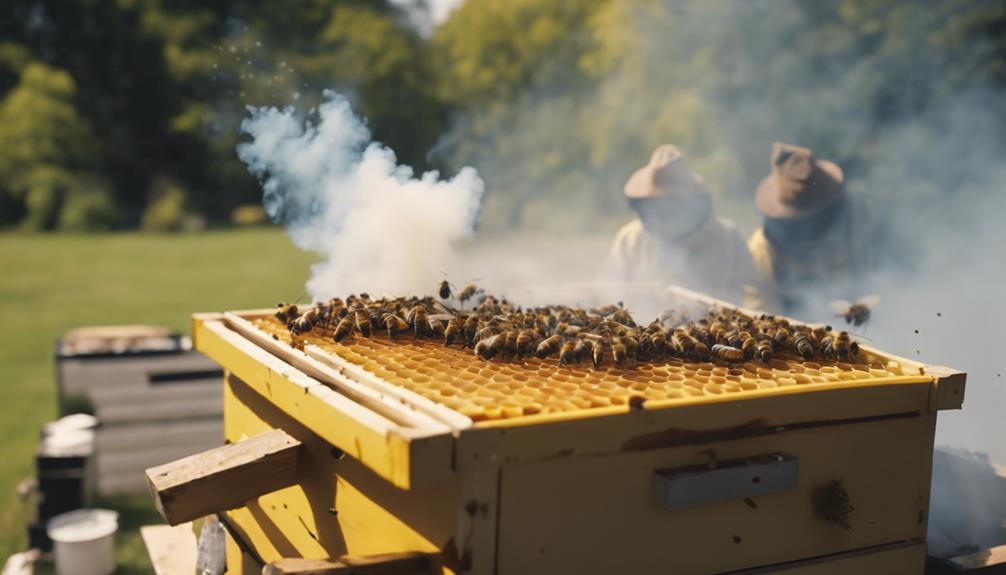
Upon exposure to smoke, bees exhibit a unique response in preparation for potential danger. Here are some fascinating behaviors bees display when encountering smoke:
- Bees prioritize consuming honey as a survival response, ensuring they’ve energy for potential threats.
- The defensive response of bees decreases, making them less likely to sting beekeepers.
- Smoke disrupts pheromone signaling, leading to reduced aggression and more peaceful interactions.
- Bees interpret smoke as a sign of wildfire anticipation, prompting them to focus on honey collection.
- Proper use of smoke allows beekeepers to work safely by distracting bees from defensive actions.
These behaviors highlight the intricate ways in which bees adapt to environmental cues, emphasizing their resilience and survival instincts.
Types of Bee Smokers
In beekeeping, the choice of fuel for a smoker significantly influences the type of smoke generated. Traditional bee smokers often use fuels like burlap, pine needles, cardboard, or herbs, creating that classic smoky scent.
On the other hand, commercial bee smoker fuels like pulped paper and cotton offer convenience for beekeepers on the go. The design of a bee smoker typically includes a burner where the fuel smolders to produce smoke.
Some modifications to traditional bee smokers include safety guards and wire cages for user protection. Remember, the fuel you choose for your bee smoker can impact the quality and effectiveness of the smoke, so it’s essential to find what works best for you and your bees.
Using Smoke in Beekeeping
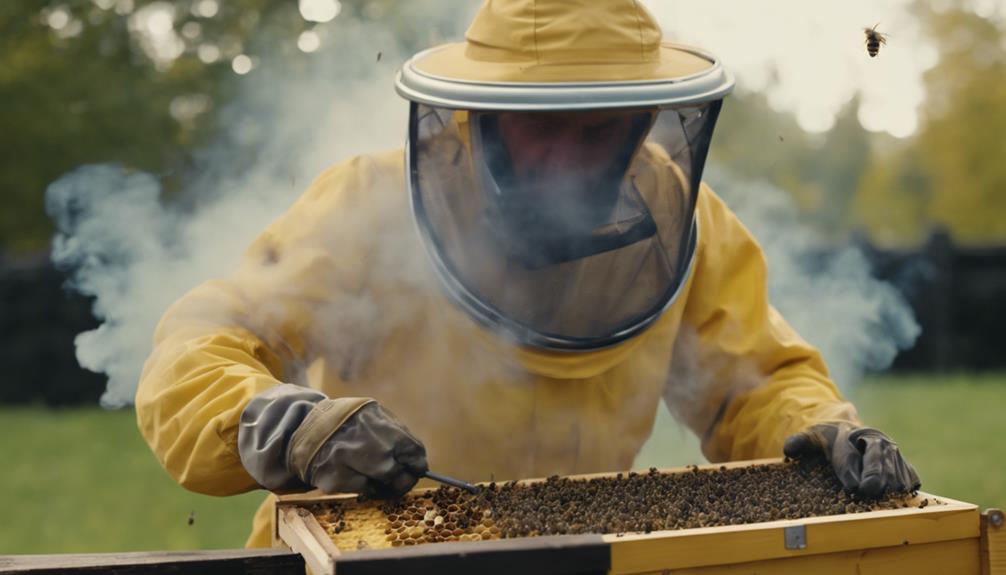
Using smoke in beekeeping serves as a vital tool for calming bees during hive maintenance, aiding in easier and safer hive inspections while minimizing the risk of bee stings. When we introduce smoke into the hive, here’s what happens:
- Smoke blocks bees’ pheromone sensitivity, helping keep them calm.
- It triggers bees’ instinctual response to wildfires, diverting their focus from defensive behavior.
- Smoke disrupts bees’ communication, preventing aggressive responses.
Proper use of smoke is essential for effective hive management. Smoke is a non-harmful method that guarantees both beekeeper and bee safety.
Benefits of Smoking Hives
Utilizing smoke in beekeeping operations provides beekeepers with a valuable tool for maintaining a vital and controlled environment within hives. The smoke calms bees by blocking their pheromone sensitivity, reducing the chances of stings and promoting a safer environment for beekeepers.
It triggers a feeding response in bees, diverting their attention towards survival rather than aggression. This efficient hive management technique not only minimizes disruptions during inspections but also guarantees beekeeper safety.
Smoke Management Techniques
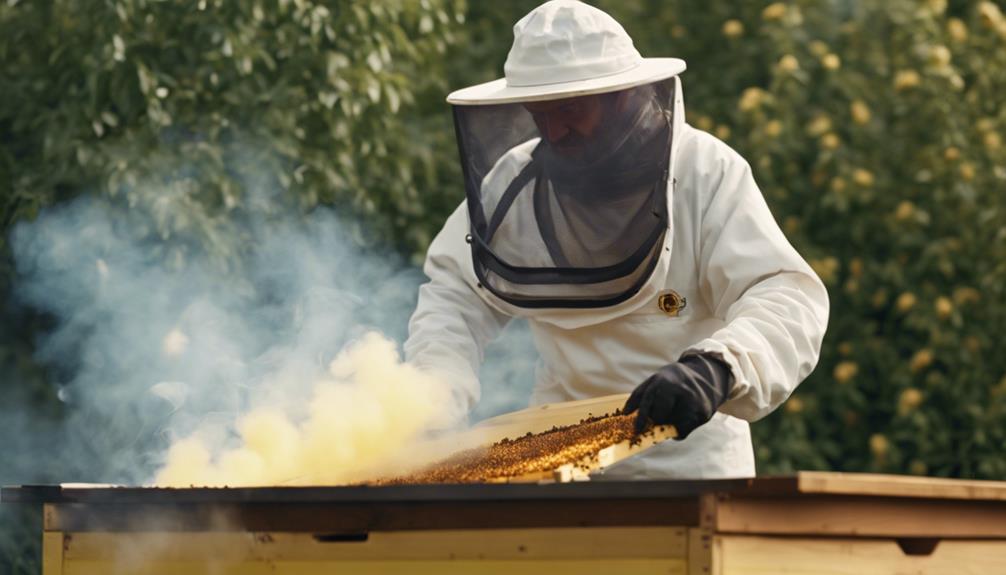
When managing bees with smokers, we employ strategic techniques to guarantee effective hive inspections and minimize disruptions. Here are some key smoke management techniques that help us maintain beekeeper safety and ensure the well-being of the colony:
- Calming bees through proper smoke application
- Disrupting communication to prevent defensive responses
- Minimizing stress on the colony during hive inspections
- Ensuring the correct use of smoke to maintain bee behavior
- Prioritizing beekeeper safety by following established smoke management practices

Hello! My name is Noel Calvin. I graduated from UCLA and now work as a writer at Launch Ninjas. I write blog posts that inspire and guide our readers in their entrepreneurial pursuits. I live in Pleasantville, NJ, with a peaceful yet lively atmosphere that inspires me.
Writing stories is more than just a job for me. It allows me to share my observations and satisfy my curiosity about the world. I combine my analytical skills with creative enthusiasm to delve into technology trends and startup stories. But my life isn’t limited to screens and keyboards. I value loyalty, passion, and a touch of old-fashioned charm, which I infuse into every narrative I create.
I love spending time in my garage, jamming with my band when I’m not writing. Playing the guitar and singing bring me immense joy. I also enjoy capturing ordinary and extraordinary moments through my camera lens and exploring new culinary adventures that excite my taste buds. I’m always seeking new experiences.
My family is very important to me. Joyful Sunday brunches filled with laughter and intense board game nights keep me grounded, reminding me of life’s simple pleasures.
In my world, every moment is an opportunity for discovery. Every discovery is a story worth sharing, whether a heartfelt moment at home or the pulse of technological innovations. Join me as I navigate through life, one blog post, one guitar strum, and one heartwarming family dinner at a time.
